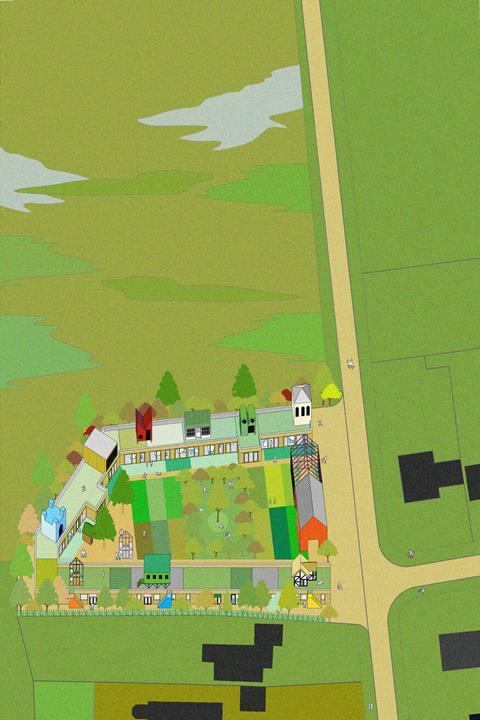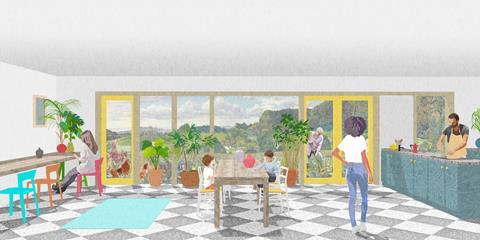Charles Holland asks how we can ensure rural housing meets the diverse needs of those who live in the countryside.

Imagine you are driving into a small town somewhere in the UK. As you approach the outskirts, where the edge of town meets the surrounding countryside, you see the signs of a new, residential development. Advertising flags are flying beside a hoarding announcing the imminent arrival of new two, three and four bed houses.
It’s a familiar scene and it is easy to visualise the outcome even before anything has been built. The houses will form a gaggle of individual brick boxes, slightly varied in size and orientation and separated by strips of lawn and timber fencing. They will be arranged along a new road that will wriggle through the site in a loop. Sometimes an effort will have been made to add variety to the units via vernacular details or patches of timber cladding, but the recipe is essentially always the same.
The question is: why does almost all rural housing look like this? And why is it dominated by a single development model? The answer lies at the intersection of planning policy and development economics.
The first issue is planning policy. Faced with five-year housing land supply requirements (at least until the Levelling Up and Regeneration Bill) and public resistance to building in the countryside, the obvious route for local authorities has been to limit development to allocated sites on the edge of existing towns and villages.
The red line around these sites means that developments can’t address anything beyond their immediate boundary. The result is that the back of every new housing development looks exactly like the back of something would if no thought had gone into it.
There is very little incentive to innovate, because this simply means adding risk
The second issue is development economics. In general, housebuilders follow a ”low-risk, maximum profit” route. Their model is to turn over land as fast as possible, selling properties freehold with the remaining access routes and shared bits of landscape adopted by the Local Authority.
After this they can move on, avoiding any long-term involvement in the site. There is very little incentive to innovate, because this simply means adding risk. In this scenario, keeping demand high is more important than meeting housing needs.
Very few organisations can compete with the big operators when it comes to housing. A handful of very large companies dominate the market and smaller, local developers tend to copy their model. Supply chains and the commercial logic of using largely standardised units and construction details – tweaked to fit local demands for contextual references – further closes down options.
We can, and should, do new housing better. We could make it less land-hungry, less car-dependent and more affordable. We could make it represent a greater diversity of lifestyles, catering for extended or blended families, communities who want to live together or older residents who want to downsize.
We could design it for people who want to work from home or grow their own food or start their own businesses. We could make it easier for people to customise their homes or live in ways that are not prescribed simply by the number of bedrooms they can afford.

We could – in short - have a far greater variety of homes and a far greater choice over how we live.
So what do we need to do enable this to happen? What policies might help unlock resistance to building in the countryside and offer genuine diversity of housing design – something that might really address local needs, reflect a wider plurality of taste and add positively to the built legacy of our towns and villages? Here are a few pointers.
Firstly, we can invest in and empower local authorities and planning departments to act with greater ambition and actually plan and build new settlements. That could mean developing new villages; places that contain a genuine variety of use, landscape, amenity and infrastructure as well as houses. Increasingly flexible models of working make such places potentially viable even without the ambitious rural public transport policy that is undoubtedly also needed.
We can also make it easier for a wider variety of developer models to work, encouraging local authorities to work with community land trusts and co-operative housing groups. We can also explore models beyond the ubiquity of single, owner occupier freeholds. More enlightened rental models that offer residents lifetime security would also involve developers and housing associations in long-term thinking and stewardship.
In 2022 my practice was part of a multi-disciplinary team awarded the Davidson Prize for proposing a new form of rural housing. Located on a typical, brown-field site, our team’s design explores flexible models of spatial organisation and ownership, offering simple timber-framed units that can be adapted and extended over time.
We worked with artist Verity-Jane Keefe to understand the way that people adapt and modify their own homes and with Joseph Zeal-Henry to develop a model of stewardship and governance that could manage the houses over time. The Quality of Life Foundation formed the fourth member of the team, applying their principles of measuring the success of new housing to the development of the design.
Our winning proposal draws on a history of innovative rural housing including plotland, self-build and cooperative models. It explores one way that new housing can become more flexible and responsive to context and need. There are others. What is needed beyond this is a progressive government willing to intervene meaningfully in the way that housing is supplied, rather than focus on demand-side tweaks.
This is not about traditional versus modern architecture or the taste of architects versus ordinary people or any other aspect of the culture wars that dominate our housing debates generally. It is about how our rural towns and villages can start planning and building the sustainable communities of tomorrow.

Postscript
Charles Holland is principal of Charles Holland Architects and Professor of Architecture at the University for the Creative Arts, Canterbury.
















3 Readers' comments